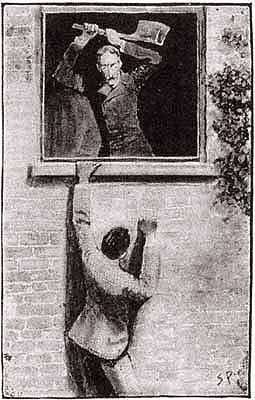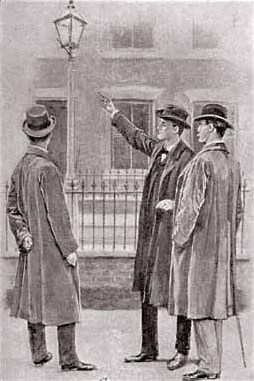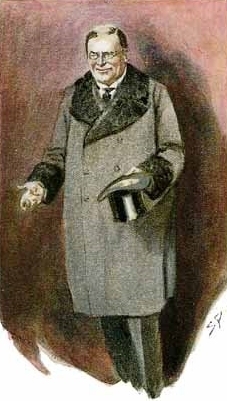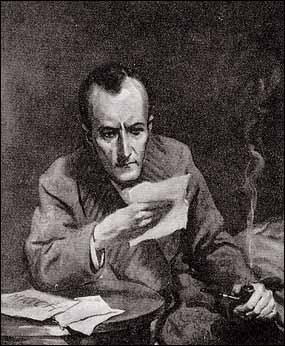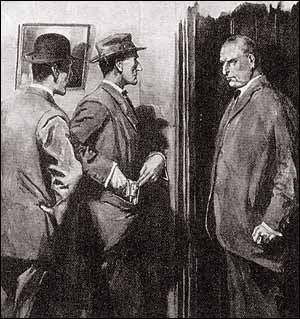Plot summary
John Turner, a widower and a major landowner who has a daughter named Alice, lives in Herefordshire with a fellow expatriate from Australia, Charles McCarthy, a widower who has a son named James. Charles has been found dead near Boscombe Pool; it was reported that he was there to meet someone. Two witnesses testify that they saw Charles walking into the woods followed by James, who was carrying a gun. Patience Moran, daughter of a lodgekeeper, says that she saw the two arguing and that, when James raised his hand as if to hit his father, she ran to her mother; and while she was telling her mother what she saw, James rushed to their house seeking help. The Morans followed James back to the Pool, where they found his father dead. James was arrested and charged with murder. Alice believes that James is innocent and has contacted Inspector Lestrade, who in turn seeks help from Sherlock Holmes.
James confirms the testimonies of the witnesses but explains that he was going into the woods to hunt, not to follow his father. He later heard his father calling "Cooee" and found him standing by the pool, surprised to see him. They argued heatedly, and James decided to return to their farm. Shortly after that he heard his father cry out and returned to find him lying on the ground. James insists that he tried to help him, but his father died in his arms. James refuses to give the cause of their argument, despite the coroner's warning that it could be damaging to his case if he does not reveal it. James also remembers that his father's last words were something about "a rat", but James is uncertain of their meaning in the situation. He also thinks he saw a cloak on the ground, which vanished while he was helping his father.
Alice meets Holmes, Lestrade and Dr. Watson in a hotel, and hopes that Holmes has found a way to prove James's innocence. She also believes that she was the subject of the argument between the McCarthys – Charles wanted his son to marry her, but James had refused. Alice had taken James' side out of respect for him, and her father was also against the union. Holmes asks Alice if he could meet her father, but she says his health worsened after the death of Charles, whom he had known since they were in Victoria. Holmes decides to see James.
Holmes mistakenly surmises that James knows who killed his father and is protecting someone. It emerges that Alice is right about the cause of the argument between James and Charles. What she does not know is that James actually loves her but could not follow his father's demand because he had married a barmaid before Alice had returned from boarding school. This burdened him, but he could not tell his father about his marriage because he would have been kicked out of the house and left unable to support himself. When his wife heard of his troubles, however, she confessed that she was already married before they met, and therefore their marriage is invalid.
Holmes, Watson and Lestrade go to the farm, and examine Charles's and James's boots. They then head to Boscombe Pool, following the track from the courtyard. After examining the ground, Holmes finds evidence of the presence of another man, besides Charles and James, whom he believes to be the murderer. Holmes deduces that the killer is left-handed (because Charles was struck neatly on the left side of his head from behind, where a right-handed man would have struck him on the other side), and that the stranger is tall, has a limp and smokes cigars. Lestrade is not convinced.
At the hotel, Holmes explains to Watson that "Cooee" is an Australian cry and that the apparent reference to "a rat", overheard by James, in fact comprised the last syllables of "Ballarat", a place in Australia. The person Charles was meeting was, therefore, someone he knew from Australia. John Turner, Alice's father, then comes to their room (coincidentally being announced by a hotel employee right as Watson is about to name him as the killer, after correctly interpreting the hints Holmes has offered him), entering with a limp, and, realising that Holmes has deduced the crime, confesses.
In his confession, John explains that he was a member of the Ballarat Gang, a group of bushrangers in Australia. They robbed a gold convoy in which Charles was the wagon driver, and John spared his life despite knowing that Charles could later identify him. The loot made the surviving gang members rich, and they moved to England. Resolved to change, John parted ways with his friends. He bought land and got married, and then Alice was born. Some time later, Charles tracked down John and threatened to blackmail him unless he and his son were provided for. In response, John gave Charles the farm and money, hoping this would satisfy him. However, this was not enough, and Charles eventually demanded the marriage of James and Alice. Although he liked James, John did not want Charles' "cursed blood" mixed with his family's, so he resisted the union. After much pressure, John agreed to meet Charles secretly at the Pool to resolve the matter. Seeing Charles and James there arguing, John hid, intending to wait until James left. However, he became angry when he heard the nature of the argument and killed Charles to preserve his freedom and spare his daughter. James heard his father's death cry and returned, but John was able to hide in the woods. He had to return later to retrieve the cloak that he had dropped in his haste.
John signs his statement, and Holmes vows to keep it secret unless it is needed to free James. In the end, Holmes's objections are sufficient to acquit James, and John dies seven months after the meeting with Holmes and Watson. Meanwhile, Watson surmises that James and Alice will likely marry and live in happiness without ever discovering the true history of their fathers.







